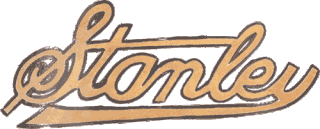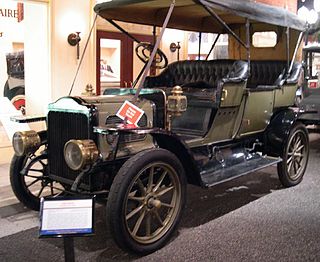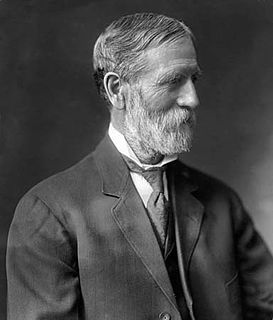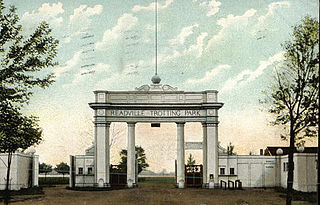Related Research Articles

Watertown is a city in Middlesex County, Massachusetts, and is part of Greater Boston. The population was 35,329 in the 2020 census. Its neighborhoods include Bemis, Coolidge Square, East Watertown, Watertown Square, and the West End.
The White Motor Company was an American automobile, truck, bus and agricultural tractor manufacturer from 1900 until 1980. The company also produced bicycles, roller skates, automatic lathes, and sewing machines. Before World War II, the company was based in Cleveland, Ohio. White Diesel Engine Division in Springfield, Ohio, manufactured diesel engine generators, which powered U.S. military equipment and infrastructure, namely Army Nike and Air Force Bomarc launch complexes, and other guided missile installations and proving grounds, sections of SAGE and DEW Line stations, radars, Combat Direction Centers and other ground facilities of the U.S. aerospace defense ring, such as the Texas Towers.

A steamboat is a boat that is propelled primarily by steam power, typically driving propellers or paddlewheels. Steamboats sometimes use the prefix designation SS, S.S. or S/S or PS ; however, these designations are most often used for steamships.
The Locomobile Company of America was a pioneering American automobile manufacturer founded in 1899, and known for its dedication to precision before the assembly-line era. It was one of the earliest car manufacturers in the advent of the automobile age. For the first two years after its founding, the company was located in Watertown, Massachusetts. Production was transferred to Bridgeport, Connecticut, in 1900, where it remained until the company's demise in 1929. The company manufactured affordable, small steam cars until 1903, when production switched entirely to internal combustion-powered luxury automobiles. Locomobile was taken over in 1922 by Durant Motors and eventually went out of business in 1929. All cars ever produced by the original company were always sold under the brand name Locomobile.

A paddle steamer is a steamship or steamboat powered by a steam engine that drives paddle wheels to propel the craft through the water. In antiquity, paddle wheelers followed the development of poles, oars and sails, where the first uses were wheelers driven by animals or humans.
Steamer may refer to:

The Brass Era is an American term for the early period of automotive manufacturing, named for the prominent brass fittings used during this time for such things as lights and radiators. It is generally considered to encompass 1896 through 1915, a time when these vehicles were often referred to as horseless carriages.

The Stanley Motor Carriage Company was an American manufacturer of steam cars; it operated from 1902 to 1924. The cars made by the company were colloquially called Stanley Steamers, although several different models were produced.

A steam car is a car (automobile) propelled by a steam engine. A steam engine is an external combustion engine (ECE) in which the fuel is combusted outside of the engine, unlike an internal combustion engine (ICE) in which fuel is combusted inside the engine. ECEs have a lower thermal efficiency, but carbon monoxide production is more readily regulated.

Grout Brothers was a manufacturer of steam-powered automobiles in Orange, Massachusetts. The three brothers, Carl, Fred and C.B. were set up in business by their father William L., who had made sewing machines under the New Home name in partnership with Thomas H. White. The early cars were sold under the New Home name.
Abner Doble was an American mechanical engineer who built and sold steam-powered automobiles as Doble Steam Cars. His steam engine design was used in various automobiles from the early 1900s, including a 1969 General Motors prototype and the first successful steam-powered aeroplane.

Francis Edgar Stanley, also known as F. E. Stanley, was an American businessman and was the co-founder, along with his twin brother Freelan Oscar Stanley, of the Stanley Motor Carriage Company which built the Stanley Steamer.

Freelan Oscar Stanley was an American inventor, entrepreneur, hotelier, and architect. He made his fortune in the manufacture of photographic plates but is best remembered as the co-founder, with his brother Francis Edgar Stanley, of the Stanley Motor Carriage Company which built steam-powered automobiles until 1920. He also built and operated the Stanley Hotel in Estes Park, Colorado.

Sankaty was a propeller-driven steamer that served as a ferry to Martha's Vineyard and Nantucket in Massachusetts; in Rockland, Maine; Stamford, Connecticut and Oyster Bay, Long Island in the United States from 1911 to 1940. During World War II, the ship was requisitioned by the Royal Canadian Navy for service as a minelayer and maintenance vessel along the Canadian Atlantic coast. Following the war the ship returned to a ferry, working the Wood Islands, Prince Edward Island and Caribou, Nova Scotia route in Canada from 1947 until 1964. While being towed to the breaker's yard, the ship sank off the coast of Nova Scotia on October 27, 1964.

The history of steam road vehicles comprises the development of vehicles powered by a steam engine for use on land and independent of rails, whether for conventional road use, such as the steam car and steam waggon, or for agricultural or heavy haulage work, such as the traction engine.

The Ross was a brass era steam automobile built in Newtonville, Massachusetts from 1906 to 1909.

The Readville Race Track located in Readville, Massachusetts had a famous and exciting history for Harness Racing, Motorcycle Racing, Auto Racing and early military combat Aviation. When the track officially opened on August 25, 1896, it quickly became one of the premier venues for harness racing in the United States. It was known as one of the country's fastest courses and many records were broken there. In 1903 history was made at Readville when a five-year-old mare named Lou Dillon became the first trotter to run a two-minute mile. On August 25, 1908 the most spectacular event in all harness horse history was staged, the $50,000 American Trotting Derby won by Allan Winter.
Thomas C. Marshall Jr. was a philanthropist, historian, antique car collector and one of the world's top authorities on Stanley Steamer automobiles in Yorklyn, Delaware. Prior to his death, his home and adjoining land was created into the Auburn Valley State Park.
References
- ↑ Kimes, Beverly. standard catalog of American Cars 1805-1942 .
^ Keith Marvin, "American Steam Car", in G.N. Georgano, ed., The Complete Encyclopedia of Motorcars 1885-1968 (New York: E.P. Dutton and Co., 1974), pp. 42.